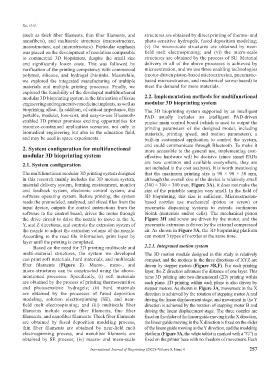Page 265 - IJB-8-4
P. 265
Xu, et al.
(such as thick fiber filaments, thin fiber filaments, and structures are obtained by direct printing of thermo- and
nanofibers), and multiscale structures (macrostructure, photo-sensitive hydrogels, fused deposition modeling;
mesostructure, and microstructure). Particular emphasis (v) the micro-scale structures are obtained by near-
was placed on the development of resolution comparable field melt electrospinning; and (vi) the micro-scale
to commercial 3D bioprinters, despite the small size structures are obtained by the process of SE. Material
and significantly lower costs. This was followed by delivery in all of the above processes is achieved by
verification of the printing competency with commercial microextrusion, and we use three enabling technologies
polymer, silicone, and hydrogel (bio)inks. Meanwhile, (motor-driven piston-based microextrusion, pneumatic-
we explored the integrated manufacturing of multiple based microextrusion, and mechanical screw-based) to
materials and multiple printing processes. Finally, we meet the demand for more materials.
explored the feasibility of the developed multifunctional
modular 3D bioprinting system in the fabrication of tissue 2.2. Implementation methods for multifunctional
engineering and regenerative medicine implants, as well as modular 3D bioprinting system
bioprinting afloat. In addition, of critical importance, this The 3D bioprinting system supported by an intelligent
portable, modular, low-cost, and easy-to-use Bluetooth- PAD usually includes an intelligent PAD-driven
enabled 3D printer promises exciting opportunities for printer main control board (which is used to output the
resource-constrained application scenarios, not only in printing parameters of the designed model, including
biomedical engineering but also in the education field, materials, printing speed, and motion parameters), a
and may be used in space experiments. built-in customized application to control the system,
and could communicate through Bluetooth. To make it
2. System configuration for multifunctional more accessible to the general use, implementing cost-
modular 3D bioprinting system effective hardware will be decisive (since smart PADs
2.1. System configuration are now common and available everywhere, they are
not included in the cost analysis). It is worth mentioning
The multifunctional modular 3D printing system designed that the maximum printing size is 90 × 90 × 50 mm,
in this research mainly includes the 3D motion system, although the overall size of the device is relatively small
material delivery system, forming environment, monitor (300 × 300 × 300 mm, Figure 3A), it does not make the
and feedback system, electronic control system, and size of the printable samples very small. In the field of
software operating system. Before printing, the system 3D bioprinting, this size is sufficient. Microextrusion-
reads the premodeled, analyzed, and sliced files from the based nozzles use mechanical (piston or screw) or
input device, outputs the control instructions from the pneumatic dispensing systems to extrude continuous
software to the control board, drives the motor through bioink (materials and/or cells). The mechanical piston
the drive circuit to drive the nozzle to move in the X, Figure 3H and screw are driven by the motor, and the
Y, and Z directions, and controls the extrusion system of pneumatic extrusion is driven by the external compressed
the nozzle to adjust the extrusion volume of the nozzle. air. As shown in Figure 3A, the 3D bioprinting platform
According to the read file information, print layer by can mount 3 types of nozzles at the same time.
layer until the printing is completed.
Based on the need for 3D printing multiscale and 2.2.1. Integrated motion system
multi-material structures, the system we developed The 3D motion module designed in this study is relatively
can print soft materials, hard materials, and multiscale compact, and the motions in the three directions of XYZ are
fiber filaments (Figure 2). Macro-, meso-, and driven by stepper motors (Figure 3B,F). For each printing
micro-structures can be constructed using the above- layer, the Z direction advances the distance of one layer. This
mentioned processes. Specifically, (i) soft materials turns 3D printing into two-dimensional (2D) printing within
are obtained by the process of printing thermosensitive each plane. 2D printing within each plane is also driven by
and photosensitive hydrogels; (ii) hard materials stepper motors. As shown in Figure 3A, movement in the X
are obtained by the processes of fused deposition direction is achieved by the rotation of stepping motor A and
modeling, solution electrospinning (SE), and near- driving the linear displacement stage, and movement in the Y
field melt electrospinning; and (iii) multiscale fiber direction is achieved by the rotation of stepping motor B and
filaments include coarse fiber filaments, fine fiber driving the linear displacement stage. The three nozzles are
filaments, and nanofiber filaments. Thick fiber filaments fixed on the slider of the linear guide moving in the X direction,
are obtained by fused deposition modeling process, the linear guide moving in the X direction is fixed on the slider
thin fiber filaments are obtained by near-field melt of the linear guide moving in the Y direction, and the modeling
electrospinning process, and nanofiber filaments are platform (Figure 3A, the white tablet is marked with a “G”) is
obtained by SE process; (iv) macro- and meso-scale fixed on the printer base with no freedom of movement. Each
International Journal of Bioprinting (2022)–Volume 8, Issue 4 257

